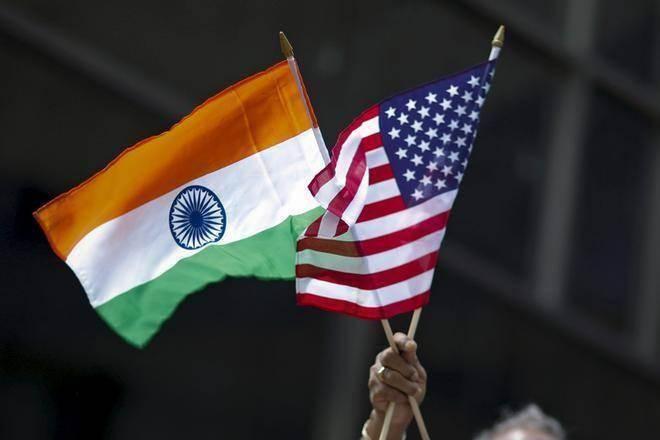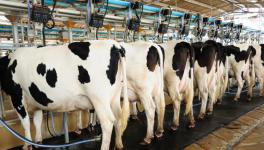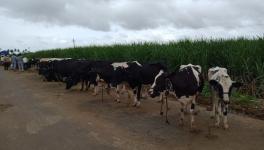How Trade Deal With America Will Inflame Rural Distress

Representational Image. Image Courtesy: Financial Express
After the failure of a big trade deal, India is now said to be in talks for a Free-Trade Agreement (FTA) with the United States. There are fresh indications that “Stage One” of such an agreement may be announced in the near future, after American President Donald Trump hinted in February on his visit here that such a deal is in the works. A report citing anonymous commerce ministry sources published in the Times of India said on 16 July that the two countries have discussed the possibility of negotiating a FTA and have expressed a desire to conclude the talks for an initial trade package. A priority objective on the American side, according to such reports, is to increase the market access to American firms to farm and dairy markets in India, among other items.
However any hike in farm, dairy and poultry exports to India from the United States is likely to significantly aggravate the distress of farmers of India. India’s farmers, including dairy and poultry farmers, are already going through a difficult time. Recently the United States increased its exports to countries such as Vietnam , South Africa and Mexico and it has magnified the problems of their farmers.
In India the average typical holding of a farmer is of around a hectare, compared with 176 hectares in the United States. So this is not competition or trade deal among equals. What is more, farm and food sector in the United States is increasingly dominated by a small number of very large multinational companies. Farming in the United States, and these businesses, are very heavily subsidised by the United States government, whose enormous resources cannot be matched by other countries. Hence the United States can easily export at rates which are far below the cost of production in developing countries. This always means that the market of small farmers in developing countries would be wiped out. A FTA is likely to considerably boost large imports into India compared to the trade regime which exists at present.
This risk is likely to be very high for maize and soybean in particular, including soybean oil, for which the United States is a huge exporter and very keen to find new assured markets to export to. For millions of farmers in India maize and soybean crops are a primary source of livelihood.
The issue of adverse impact on dairy farmers is an even bigger one as dairy farmers are spread all over India and face increasing problems due to decline of pastures and increase of fodder and feed costs. Around 70 million Indian farmer families are sustained by dairying. The factors which made dairying a low-cost enterprise are in rapid decline, while the small dairy farmer has to compete with packaged milk which can be produced inexpensively by mixing stored skimmed milk powder. Costs are even higher for the landless dairy farmers. On the other hand, a typical dairy farm in the United States has over a thousand cows, while bigger ones can have over ten thousand heads of cattle. These farms also get large government subsidies and are dominated by a few prominent companies. India’s small and landless dairy farmers will not be able to compete in such an unequal match.
No doubt the ruse of lower milk prices will be deployed to lure Indian consumers into supporting the FTA and its dairy-import component, however, the government’s concern ought to be to protect and support its own farmers to produce more and better-quality milk and milk products. India has attained self-sufficiency in milk production after a sustained effort. According to the NDDB or National Dairy Development Board, India produced 176 million tonnes milk in 2017 and therefore does not need imported milk. Other estimates say that India’s contribution to world milk production rose from 5% in the 1960s to roughly 17%.
Similarly, the poultry sector in India has a large number of very small units. It is not possible for them to compete against those who sell even below the cost of production. Some United States poultry companies have frequently been criticised for the tendency to dump frozen chickens parts and other poultry products on other countries. Further, the poultry sector in India is growing rapidly too. The production of eggs and broilers is rising at eight to 10% annually, as a number of large units are setting up, which occasionally support smaller producers. Indian farmers and breeders have tremendous capability in this field, and the Indian government should accordingly spend time and resources on amping up domestic production. It is expected that the demand for eggs and broilers will only grow over time. According to an FAO analysis of the National Sample Survey data, 68% of households are non-vegetarians, and the proportion is growing. Citing NSSO data, it says, “...between 1987-88 and 1999-2000, the proportion of households consuming only one of the three items—fish, meat or eggs—increased by only 1% in urban areas, while in rural areas this proportion increased by 4%”. Hence the imports from the United States of these items would mark an intrusion into the growing rural market, which itself is an unwelcome idea.
This US-India trade agreement can also have a very adverse impact on health and nutrition as farm exports which the United States is very keen to promote have a significant component of genetically modified (GM) crops and foods. Maize and soybean crops produced in the United States are mainly GM. Milk production in the country is being boosted with a GM “growth hormone” which has been criticised as hazardous to health.
In India, GM food and crops are banned on health and environmental grounds, and to safeguard India’s agriculture from potentially serious harm. But when a FTA is signed with a powerful country that has huge commercial interest in promoting and exporting GM food, then the likelihood of pressure for acceptance of GM foods will grow. In fact, the heat is already on India, and is likely to get warmer. A large number of multinational companies which are trying to promote GM crops in order to dominate the world food system are based out of the United States.
There are also wider concerns over the extent to which American food and agribusiness companies will permeate the Indian market and loosen the regulatory framework for the sake of dominating the country’s food industry. The contract-farming system will allow massive and resource-rich companies a much bigger say in crop choice and their end uses, thereby impacting food security and agro-environmental conditions. At present, the staple food crops, by and large, have a very high priority in India, but powerful interests can make other demands that can raise fresh health risks.
Yet another area of serious concern is that India’s relatively independent stand on safeguarding the seed rights of farmers will be compromised further. Attempts are on to push India closer to recognising patent rights of seed companies including those owned by the dominant multinational concerns.
All these adverse consequences may not roll out in the first phase of the FTA but the general trend will be predictably along these lines. Hence it is important to keep a close watch on the discussions and prepare to protect farmers and safeguard the health, nutrition and environment of the country. Organisations that believe in protecting the interests of farmers and farming, those who work for health, nutrition, environment and concerns of consumers, must unite for this battle.
The writer is a freelance journalist who has been involved with social movements. The views are personal.
Get the latest reports & analysis with people's perspective on Protests, movements & deep analytical videos, discussions of the current affairs in your Telegram app. Subscribe to NewsClick's Telegram channel & get Real-Time updates on stories, as they get published on our website.
















